Lessico
Elatine
Linaria elatine
Kickxia elatine
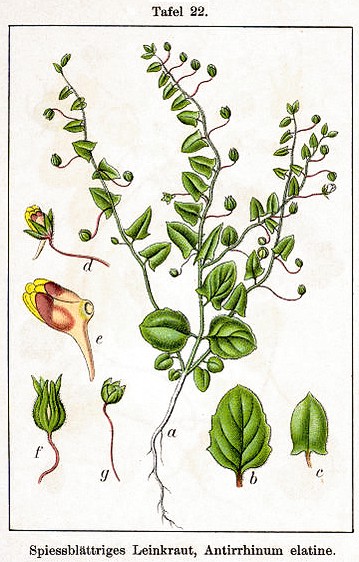
Elatínë č il nome greco di una pianta descritta da
Dioscoride![]() . Essa dovrebbe corrispondere alla Linaria
elatine oggi nota col nome di Kickxia elatine o cencio minore.
Dioscoride dice che ha le foglie simili a quelle della helxínë*, cioč
il vilucchio (Convolvolus arvensis), ma Pierandrea Mattioli
. Essa dovrebbe corrispondere alla Linaria
elatine oggi nota col nome di Kickxia elatine o cencio minore.
Dioscoride dice che ha le foglie simili a quelle della helxínë*, cioč
il vilucchio (Convolvolus arvensis), ma Pierandrea Mattioli![]() si astiene dall'identificarla in quanto non gli č
mai capitato di imbattersi in questa pianta.
si astiene dall'identificarla in quanto non gli č
mai capitato di imbattersi in questa pianta.
La Linaria elatine (o Kickxia elatine che dir si voglia, famiglia Scrophulariaceae o Plantaginaceae a seconda degli studiosi), detta volgarmente soldino o linaria abietiforme (in questo caso a elatine viene dato il significato di simile all’abete, detto elátinos in greco), č una pianta annua estiva che germina in primavera e fiorisce dall’estate all’autunno, con fiori gialli e labbro superiore violaceo. Cresce nelle colture di cereali, campi, stoppie, maggesi, e arreca danni da esigui a medi per lo spazio che occupa e l’azoto che sottrae.
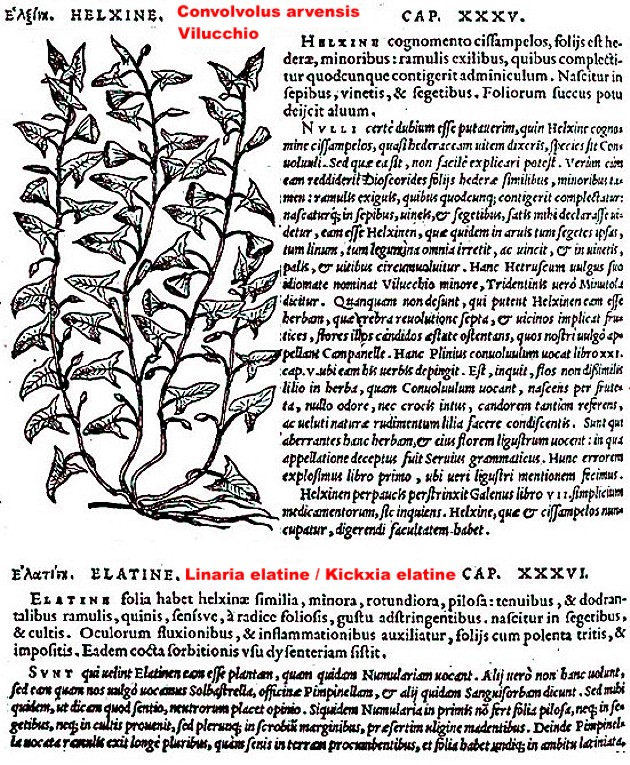
L'elatine
di Dioscoride che č detta avere le foglie simili all'helxine
nel trattato di Pierandrea Mattioli
Commentarii
in libros sex Pedacii Dioscoridis Anazarbei De Materia Medica (1554)
![]()
Le
due elatine di Mathias de Lobel![]()
in Plantarum seu stirpium icones -
1581
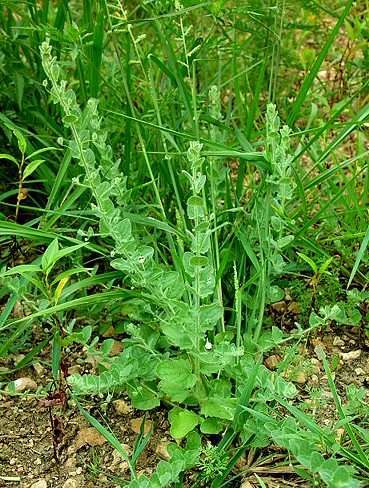
Family - Scrophulariaceae
Stems - From a large taproot, multiple from base, central stem erect, lateral stems ascending, all stems branching, herbaceous, to 70cm long, pubescent with both short and long hairs. Some of the hairs glandular.
Leaves - Alternate, short-petiolate. Petiole to 5mm long, pubescent as the stem. Blades generally ovate, toothed or lobed in lower 1/2 to 2/3, to 3cm long and broad, pubescent above and below, rounded to subacute at the apex. Leaves greatly reduced upward and becoming acute and densely pubescent.
Inflorescence - Single axillary flowers along the length of the stem. Pedicels thin, mostly spreading at 90 degrees to the stem, +/-2cm long, pubescent.
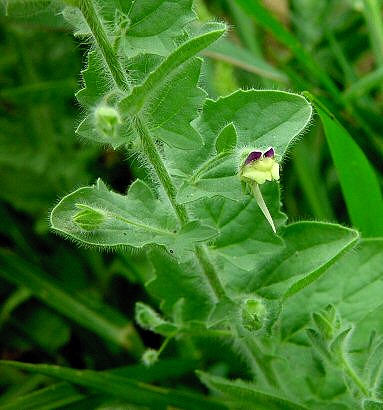
Flowers - Corolla spurred, bilabiate. Spur to 8mm long, densely pubescent, exserted from between the bottom two calyx lobes, reflexed at maturity. Upper lip 2-lobed. Lobes purple, rounded at apex, to 3mm long, pubescent externally, glabrous internally. Lower lip irregular, yellow at apex, pubescent internally and externally, shallowly 3-lobed. Stamens 4, included under the upper lip of the corolla, adnate at the base of the corolla tube, didynamous, apically connate. Filaments greenish-white, to 4mm long, pilose. Anthers purple, pubescent on margins, -1mm long. Ovary superior, subtended by a green ring-like nectary, pubescent, green, globose, 1mm in diameter, 2-locular. Placentation axial. Ovules many. Style pubescent, 2.1mm long, greenish-white, slightly swollen below the stigma. Calyx 5-lobed to weakly bilabiate. Lobes lanceolate, acute, densely pubescent externally and internally, to 4mm long, -2mm broad. Calyx tube to -1mm long. Upper lip 3-lobed. Lower lip 2-lobed.
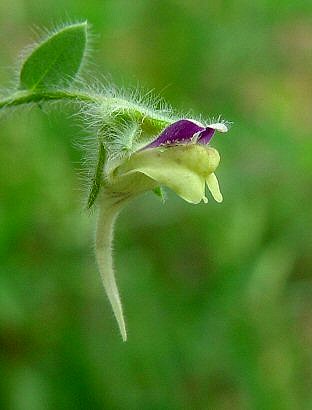
Flowering - May - October.
Habitat - Sand and gravel bars along streams, streambanks, waste ground, railroads.
Origin - Native to Europe.
Other info - This species can be found throughout the lower 1/2 of Missouri. Another species, K. spuria (L.) Dum., is sometimes recognized but is probably synonymous with K. elatine.
www.missouriplants.com
Kickxia elatine
Kickxia is a genus of plants in the Plantaginaceae family. It includes several species of plants known commonly as cancerworts or fluellins. They are mostly native to Europe, but two species, K. elatine and K. spuria are well-known elsewhere as invasive weeds. Genus Kickxia was named after the Belgian botany professor J. J. Kickx.
Selected species:
Kickxia abhaica
Kickxia cirrhosa
Kickxia commutata
Kickxia elatine - sharpleaf cancerwort, pointed toadflax
Kickxia incana
Kickxia lanigera
Kickxia papillosa
Kickxia spuria - roundleaf cancerwort
Kickxia elatine (Plantaginaceae) is a species of flowering plant in the plantain family known by several common names, including sharpleaf cancerwort and sharp-leaved fluellin. It is native to Europe and Asia, but it is present on other continents as an introduced species, and sometimes a noxious weed. This is a small hairy herb with a trailing stem with many branches. It produces oval to arrowhead-shaped fuzzy leaves at wide intervals along the slender stem, and solitary snapdragon-like flowers borne on long, straight pedicels. Each flower is up to 1.5 centimeters long with a narrow, pointed spur extending from the back. The lobes of the mouth are yellow, white, and purple, and the whole flower is fuzzy to hairy. The fruit is a spherical capsule about 4 millimeters long.